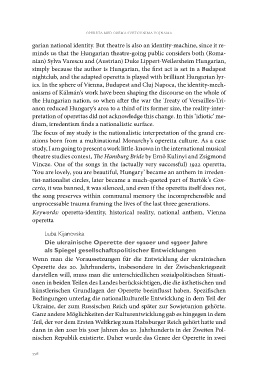Page 558 - Weiss, Jernej, ur./ed. 2021. Opereta med obema svetovnima vojnama ▪︎ Operetta between the Two World Wars. Koper/Ljubljana: Založba Univerze na Primorskem in Festival Ljubljana. Studia musicologica Labacensia, 5
P. 558
opereta med obema svetovnima vojnama
garian national identity. But theatre is also an identity-machine, since it re-
minds us that the Hungarian theatre-going public considers both (Roma-
nian) Sylva Varescu and (Austrian) Duke Lippert-Weilersheim Hungarian,
simply because the author is Hungarian, the first act is set in a Budapest
nightclub, and the adapted operetta is played with brilliant Hungarian lyr-
ics. In the sphere of Vienna, Budapest and Cluj Napoca, the identity-mech-
anisms of Kálmán’s work have been shaping the discourse on the whole of
the Hungarian nation, so when after the war the Treaty of Versailles-Tri-
anon reduced Hungary’s area to a third of its former size, the reality-inter-
pretation of operettas did not acknowledge this change. In this ‘idiotic’ me-
dium, irredentism finds a nationalistic surface.
The focus of my study is the nationalistic interpretation of the grand cre-
ations born from a multinational Monarchy’s operetta culture. As a case
study, I am going to present a work little-known in the international musical
theatre studies context, The Hamburg Bride by Ernő Kulinyi and Zsigmond
Vincze. One of the songs in the (actually very successful) 1922 operetta,
‘You are lovely, you are beautiful, Hungary’ became an anthem in irreden-
tist-nationalist circles, later became a much-quoted part of Bartók’s Con
certo, it was banned, it was silenced, and even if the operetta itself does not,
the song preserves within communal memory the incomprehensible and
unprocessable trauma framing the lives of the last three generations.
Keywords: operetta-identity, historical reality, national anthem, Vienna
operetta
Luba Kijanovska
Die ukrainische Operette der 1920er und 1930er Jahre
als Spiegel gesellschaftspolitischer Entwicklungen
Wenn man die Voraussetzungen für die Entwicklung der ukrainischen
Operette des 20. Jahrhunderts, insbesondere in der Zwischenkriegszeit
darstellen will, muss man die unterschiedlichen sozialpolitischen Situati-
onen in beiden Teilen des Landes berücksichtigen, die die ästhetischen und
künstlerischen Grundlagen der Operette beeinflusst haben. Spezifischen
Bedingungen unterlag die nationalkulturelle Entwicklung in dem Teil der
Ukraine, der zum Russischen Reich und später zur Sowjetunion gehörte.
Ganz andere Möglichkeiten der Kulturentwicklung gab es hingegen in dem
Teil, der vor dem Ersten Weltkrieg zum Habsburger Reich gehört hatte und
dann in den 20er bis 30er Jahren des 20. Jahrhunderts in der Zweiten Pol-
nischen Republik existierte. Daher wurde das Genre der Operette in zwei
556
garian national identity. But theatre is also an identity-machine, since it re-
minds us that the Hungarian theatre-going public considers both (Roma-
nian) Sylva Varescu and (Austrian) Duke Lippert-Weilersheim Hungarian,
simply because the author is Hungarian, the first act is set in a Budapest
nightclub, and the adapted operetta is played with brilliant Hungarian lyr-
ics. In the sphere of Vienna, Budapest and Cluj Napoca, the identity-mech-
anisms of Kálmán’s work have been shaping the discourse on the whole of
the Hungarian nation, so when after the war the Treaty of Versailles-Tri-
anon reduced Hungary’s area to a third of its former size, the reality-inter-
pretation of operettas did not acknowledge this change. In this ‘idiotic’ me-
dium, irredentism finds a nationalistic surface.
The focus of my study is the nationalistic interpretation of the grand cre-
ations born from a multinational Monarchy’s operetta culture. As a case
study, I am going to present a work little-known in the international musical
theatre studies context, The Hamburg Bride by Ernő Kulinyi and Zsigmond
Vincze. One of the songs in the (actually very successful) 1922 operetta,
‘You are lovely, you are beautiful, Hungary’ became an anthem in irreden-
tist-nationalist circles, later became a much-quoted part of Bartók’s Con
certo, it was banned, it was silenced, and even if the operetta itself does not,
the song preserves within communal memory the incomprehensible and
unprocessable trauma framing the lives of the last three generations.
Keywords: operetta-identity, historical reality, national anthem, Vienna
operetta
Luba Kijanovska
Die ukrainische Operette der 1920er und 1930er Jahre
als Spiegel gesellschaftspolitischer Entwicklungen
Wenn man die Voraussetzungen für die Entwicklung der ukrainischen
Operette des 20. Jahrhunderts, insbesondere in der Zwischenkriegszeit
darstellen will, muss man die unterschiedlichen sozialpolitischen Situati-
onen in beiden Teilen des Landes berücksichtigen, die die ästhetischen und
künstlerischen Grundlagen der Operette beeinflusst haben. Spezifischen
Bedingungen unterlag die nationalkulturelle Entwicklung in dem Teil der
Ukraine, der zum Russischen Reich und später zur Sowjetunion gehörte.
Ganz andere Möglichkeiten der Kulturentwicklung gab es hingegen in dem
Teil, der vor dem Ersten Weltkrieg zum Habsburger Reich gehört hatte und
dann in den 20er bis 30er Jahren des 20. Jahrhunderts in der Zweiten Pol-
nischen Republik existierte. Daher wurde das Genre der Operette in zwei
556


